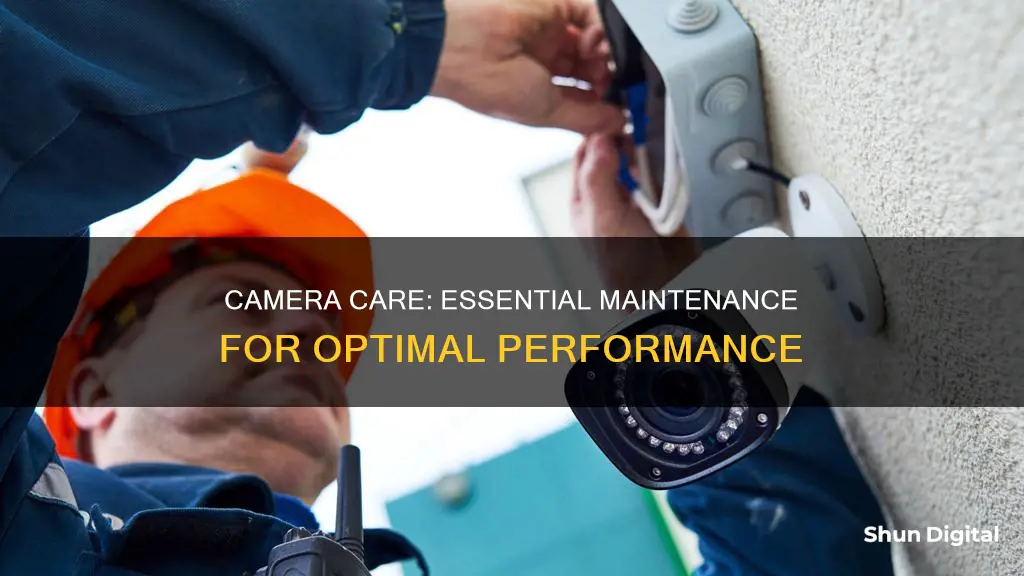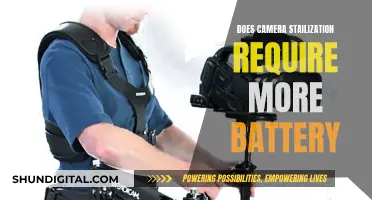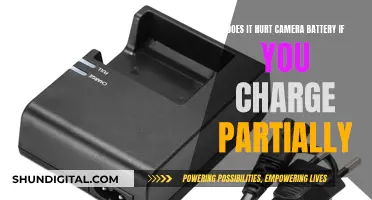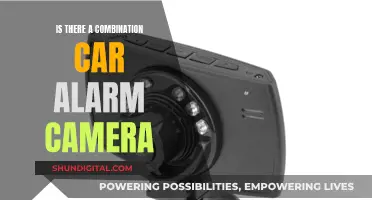
Cameras are expensive pieces of equipment, and they need to be cared for and protected. Proper care and maintenance can extend the life of your camera, saving you from having to shell out for a new one. Camera care can also improve performance and enhance the quality of your pictures. There are several steps you can take to care for your camera, from using a camera bag to protect it from the elements to using the correct cleaning products on the lens.
What You'll Learn

Protect your investment
Cameras are expensive, so it makes sense to keep them well-maintained and protected. Photography equipment is an investment, and you wouldn't want to have to spend a few thousand dollars on a new camera body because you didn't take good care of the first one. Proper care and maintenance can prevent mishaps such as dead batteries, spots on the camera sensor, and dirty lenses that can ruin a shoot and cause extra time in the editing room.
Camera bags and cases
A good camera bag or case is the first line of defence in protecting your camera. Choose one that fits your equipment and that you will actually use. It should have padding and latches or zippers to keep everything in place. There are various styles, sizes, colours, and price ranges to choose from. You can switch between different styles, such as a messenger bag and a backpack, depending on your needs.
It is also important to keep your camera bag or case in a dry, warm area, away from heaters and direct sunlight. Don't leave your camera in a cold car overnight.
Camera straps
Using a camera strap can save you from photography disasters. It doesn't matter what type of strap you choose, as long as you have and use one. A hand strap, neck strap, or harness will help protect your camera from slipping out of your hands, getting knocked over, or being stolen if you set it down during a shoot.
Tripods
If you don't like being confined by a camera strap, a tripod makes a great alternative. Keep your camera on it while shooting, or set it up next to you and snap your camera onto it when you aren't actively taking photos.
Rain covers
If you shoot in wet conditions, invest in a rain cover for your camera. Even if your gear is weather-sealed, don't take the chance of exposing it to prolonged rain. You can buy disposable clear plastic ones for a few dollars, or get a rain sleeve made of the same material as your raincoat. In an emergency, a grocery sack or Ziploc bag can also work.
Condensation
Condensation occurs when you move your camera between different temperatures, such as from a cold to a warm environment or vice versa. To prevent condensation, seal your camera and lens in an airtight bag or container before taking it into a different environment. This way, the condensation forms on the bag instead of your camera. You can also use silica gel pouches to help dry out your kit.
UV filters
While UV filters may not be necessary with today's high-tech cameras, they can provide quick protection for your camera by creating a barrier against smears, scratches, dust, and grime. They may even prevent damage to the lens if you drop the camera, depending on the force of the impact. If you don't want to use a UV filter, always carry a spare lens cap to protect the lens.
Insurance
Consider investing in a good photography insurance policy to cover you for theft, accidental damage, in-vehicle protection, and worldwide protection (exclusions may apply). Check that you are happy with the excess and consider optional extras to build a policy that suits your needs, whether you're an amateur or professional photographer.
Finding the Chevy Camaro's Battery: Location and Access
You may want to see also

Use a camera bag
Camera bags are essential for protecting your camera equipment. They come in various sizes, colours and price ranges, so you can easily find one that suits your needs and budget. Here are some reasons why using a camera bag is a good idea:
Protection from the Elements
Many camera bags are waterproof, so they will keep your camera safe and dry when you're shooting in the rain. Some bags also have straps to attach a tripod, so you don't have to worry about carrying it separately. If you're shooting in dusty or wet conditions, it's a good idea to invest in a rain cover for your camera. Even if your gear is weather-sealed, it's better to be safe than sorry. You can buy disposable clear plastic covers for a few dollars, or get a rain sleeve made from the same material as your raincoat. In an emergency, a grocery sack or Ziploc bag can also be used to protect your camera from the elements.
Keep Your Camera Safe from Damage
Camera bags are designed to keep your camera and equipment safe from scratches, dust and other potential damage. They are usually padded and have latches or zippers to keep everything securely in place. This is especially important if you're transporting your camera in a backpack or suitcase, as it can get jostled around and knocked against other items. Make sure to zip or latch your camera case when it's not in use, so that your gear doesn't accidentally fall out. It's also a good idea to keep your camera bag in a dry, warm area, away from heaters and direct sunlight.
Easy Transport
A good camera bag will have moveable padded dividers, so you can customise the space to fit your camera body and any extra lenses or equipment you need to carry. This is much safer than carrying your camera loose in a backpack or suitcase, where it could get damaged. It's also more convenient than having to carry your camera and equipment separately.
Versatility
There are many different styles of camera bags available, including messenger bags, backpacks, slings and totes. You can choose the style that best suits your needs and preferences. Some camera bags can also be used as regular bags by removing the camera cube or divider. This versatility means you don't have to buy a separate bag for your camera – you can just convert your existing bag into a camera bag using a camera cube or insert.
Peace of Mind
Knowing that your camera is safe and protected will give you peace of mind and allow you to focus on your photography. You won't have to worry about your camera getting scratched, wet or damaged, so you can fully enjoy your shooting experience.
Troubleshooting Camera Issues: Computer Registration Fix
You may want to see also

Avoid exposing your sensor
Camera care is important to protect your investment and ensure your camera lasts. Here are some tips to avoid exposing your camera sensor:
Use a Camera Bag
A camera bag is essential to protect your camera from scratches, dust, and rain. Choose a bag with padding and latches or zippers to keep your camera secure. There are various styles, sizes, colours, and price ranges available, so you can find one that suits your needs.
Be Careful When Changing Lenses
When you take off your lens, you expose the inside of your camera to dust, moisture, and debris. Change lenses carefully and avoid doing so in dusty, windy, or wet environments. Keep the camera cap screwed on when not using a lens. If possible, use a rain cover or plastic bag to protect your camera when shooting in wet conditions.
Don't Leave the Sensor Uncovered
As a general rule, avoid leaving your sensor uncovered for more than a few seconds. When removing the lens cap, be mindful of your surroundings and avoid breezy environments to minimise dust exposure.
Turn Off Your Camera
Always turn off your camera before removing or attaching lenses. When the camera is on and the sensor is uncovered, it can attract dust and debris due to the electro-polarity fields.
Face the Camera Downwards
When switching lenses, always point the camera downwards to protect the sensor from dust falling onto it.
Avoid Coughing or Sneezing Near the Camera
Be mindful of your surroundings when handling your camera. Coughing or sneezing near the camera can result in liquid landing on the sensor, requiring a swab to clean it properly.
Gardepro Cameras: Where Are They Manufactured?
You may want to see also

Pick a camera bag with enough cushioning
Camera bags are an essential accessory for photographers, helping them to keep their equipment organised and protected. When choosing a camera bag, it's important to select one with enough cushioning to protect your valuable gear. Here are some reasons why picking a camera bag with sufficient cushioning is crucial:
Protect Your Investment
Photography equipment is expensive, and proper care is necessary to protect your investment. A camera bag with ample cushioning will safeguard your camera and lenses from bumps, scratches, and other types of damage. By investing in a well-padded bag, you can avoid the costly mistake of having to replace your camera due to accidental damage.
Ensure Comfort and Convenience
Cushioning in a camera bag not only protects your equipment but also enhances your comfort while carrying it. Adequate padding distributes the weight of your gear evenly, making it more comfortable to transport, especially during extended periods. Additionally, a well-cushioned bag provides a snug fit for your camera equipment, ensuring that items don't shift around and causing unwanted noise or potential damage during transit.
Absorb Shocks and Impacts
One of the primary functions of cushioning in a camera bag is to absorb shocks and impacts. The padding acts as a barrier, preventing your delicate camera equipment from sustaining damage if the bag experiences any knocks or bumps during travel. Materials such as foam, neoprene, and rubber are commonly used for padding, with foam being a popular choice due to its lightweight and excellent shock absorption properties.
Customisable Protection
Many camera bags feature adjustable dividers and modular components that allow you to customise the layout to fit your specific needs. These dividers are typically made of foam or Velcro and can be rearranged to create compartments of various sizes, ensuring that your camera body, lenses, and accessories are securely held in place and protected from scratches or other types of damage.
Weatherproofing
In addition to cushioning, it is essential to consider weatherproofing measures when selecting a camera bag. Using a bag with adequate padding can help protect your equipment from the elements, such as rain or humidity. Look for bags with waterproof or water-resistant fabrics, rain covers, and waterproof zippers to ensure that your gear stays dry and protected from moisture.
In conclusion, choosing a camera bag with sufficient cushioning is vital to protect your equipment, ensure your comfort, and provide peace of mind while you focus on capturing stunning photographs. By investing in a well-padded camera bag, you can rest assured that your valuable gear will be safe and secure during your photographic adventures.
The Ultimate Camera for Focused Photography
You may want to see also

Avoid dirt, dust and water
Cameras are delicate pieces of equipment that require care and protection. Dirt, dust, and water can cause significant damage to your camera, so it is important to take the necessary precautions to avoid them. Here are some detailed tips to help you avoid dirt, dust, and water damage to your camera:
Use a Camera Bag:
A camera bag is essential for protecting your camera from dirt, dust, and water. It provides a safe space to store your camera when not in use and shields it from the elements. Camera bags come in various sizes, colours, and price ranges, so you can choose one that suits your needs and preferences. Some camera bags are also waterproof, offering additional protection from rain or water damage.
Be Wary of the Beach:
The beach is a high-risk location for cameras due to the presence of sand, salt, and moisture. If you must take your camera to the beach, follow these precautions:
- Avoid setting your camera directly on the sand or the ground. Carry it with you at all times.
- Wash your hands before handling the camera if you've been in the sand or water, as dirt and sand can easily transfer to the camera's buttons and lenses.
- Keep your camera and its bag away from sunscreen and bug spray, as these products contain harsh chemicals that can damage your equipment.
- Use a rain cover or waterproof housing to protect your camera and lens from dust, sand, and moisture.
- Avoid changing lenses at the beach if possible, as this exposes the camera's sensor to the elements. If you must change lenses, do so out of the wind and work quickly.
General Precautions:
In addition to the beach-specific precautions, here are some general tips to avoid dirt, dust, and water damage:
- Keep your camera in a dry, warm area when not in use, away from heaters and direct sunlight.
- Use a camera strap to secure your camera during shoots, preventing it from slipping out of your hands or being knocked over.
- Be cautious when changing lenses, as this exposes the inside of your camera to the elements. Change lenses indoors or in a clean, controlled environment, and always position the camera downward when removing or attaching a lens.
- Regularly clean your camera using a blower brush, canned air duster, or a soft brush to remove dust and dirt particles.
- Use a microfiber cloth to gently clean the camera lens, LCD screen, and other delicate surfaces.
- Store your camera in a clean, durable protective case when not in use, ensuring the case is padded enough to protect your equipment from knocks or falls.
- Be cautious with camera batteries, as they can leak acid and cause damage. Remove batteries from the camera when not in use, and store them in a corrosion-resistant container.
Tripod Mode: A Stable Camera Technique for Photographers
You may want to see also
Frequently asked questions
A camera bag protects your camera from scratches, dust, and rain. It also keeps the camera safe from extreme temperatures.
Use a blower brush to remove dust particles from the front and rear lenses. Then, carefully clean the lenses with a microfiber cloth and an alcohol solution designed for camera optics.
Allow your camera to adjust to the new environment naturally. Don't place it inside a closed plastic bag when transporting it between different temperatures.
Never overcharge your batteries and never mix old and new batteries. Always remove the battery when the camera is not in use and store it in a corrosion-resistant container.
Use a microfiber cloth to remove fingerprints and smudges. For stubborn smudges, you may need to use a commercial LCD screen cleaner.







